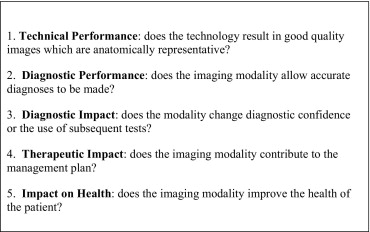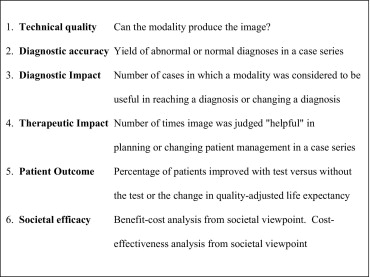Evidence-based practice (EBP) is the process of systematically finding, appraising, and using contemporary research findings as a basis for clinical and policy decisions ( ). This involves the “bottom-up” five-step process of EBP first developed in McMaster University and the Centre for Evidence-Based Medicine (CEBM) ( ) ( Fig. 1 ). “Bottom-up” is a term coined by David Sackett and Paul Glasziou, directors of the CEBM, and denotes the practice of efficiently tracking down and appraising literature at a local level and applying it to local clinical practice ( ). The Internet has facilitated this practice such that any radiologist with a clinical question can efficiently explore the relevant literature, select data at the highest level of the hierarchy of evidence knowing it is the best current evidence, apply this knowledge to problems encountered in day-to-day practice, and evaluate its impact. Solutions that work for individual problems and circumstances can be derived and put into practice, with a clear awareness of their limitations ( ).
Figure 1
The five-step process of evidence-based practice.
Step 1: Ask
The radiologist poses a focused clinical question regarding clinical data. The anatomy of the question involves four parts: the problem being addressed, the intervention being considered, the comparison of the intervention, and the outcome of interest. The EBP question format PICO can be used (Patient, Investigation, Comparison, and Outcomes of interest) ( ).
Step 2: Search
The next step is to find the evidence in the literature to answer the clinical question. There are many databases, search engines and guidelines that have facilitated EBP; of which MEDLINE and The Cochrane Collaboration may be especially useful. MEDLINE is the U.S. NLM bibliographic Website widely available to the public.
The Cochrane Collaboration is a quality filtered database that stratifies literature according to selected methodological criteria. The process of literary searching has been considered in detail in a recent Radiology article ( ). For our purposes, MEDLINE was used due to its large selection of radiological literature. The literature search was performed using MeSH terms, which applied to the clinical question.
Step 3: Appraise
The evidence retrieved is critically appraised in an explicit and structured manner to establish its validity, strength, and usefulness in practice. To effectively carry out the third step, literature is classified as belonging to one of several “domains.” Examples of domains are diagnosis, therapeutic benefit, therapeutic harm, reviews, clinical guidelines, prognosis, economic analysis, and qualitative research. The difference between evidence-based and “traditional” literature analysis is that the evidence-based researchers have described, in the peer-reviewed literature, an explicit process of appraisal for literature in each domain ( ). Factors that will act as sources of bias in study design have been identified, and mathematic analyses that will give the reader a clear idea of the strength, statistical significance, and possible clinical importance of the results are described. In addition to being located in the original literature ( ), these principles are now widely available in textbook form ( ) and on the Internet ( ). Their application to diagnostic radiology has been considered in detail in other publications ( ) and in a recent special series in Radiology ( ); interested readers are referred to these resources.
Get Radiology Tree app to read full this article<
Get Radiology Tree app to read full this article<
Technology assessment
Get Radiology Tree app to read full this article<
Get Radiology Tree app to read full this article<
Get Radiology Tree app to read full this article<
Summary
Get Radiology Tree app to read full this article<
References
1. The Evidence-Based Radiology Working Group: Evidence-based radiology: A new approach to the practice of radiology. Radiology 2001; 220: pp. 566-575.
2. Centres for Health Evidence. Users’ guides to evidence-based practice. Available at www.cche.net/usersguides/main.asp . Accessed January 10, 2007.
3. Oxman A.D., Sackett D.L., Guyatt G.H.: Users’ guides to the medical literature. I. How to get started. The Evidence-Based Medicine Working Group. JAMA 1993; 270: pp. 2093-2095.
4. Rosenberg W., Donald A.: Evidence based medicine: An approach to clinical problem-solving. BMJ 1995; 310: pp. 1122-1126.
5. Staunton M.: –Asking Answerable Questions and Searching for Evidence. Radiology 2007; 242: pp. 23-31.
6. Sackett D.L., Strauss S.E., Richardson W.S., Rosenberg W., Haynes R.B.: 2nd ed.2000.Churchill LivingstonePhiladelphia
7. Guyatt G.H.: 2002.American Medical AssociationChicago
8. McMaster University (Hamilton, Ontario, Canada). Users’ guides to the medical literature: a manual for evidence-based practice. Available at www.usersguides.org . Accessed January 10, 2007.
9. McMaster University (Hamilton, Ontario, Canada). Health Information Research Unit (HIRU): Evidence-based health informatics. Available at hiru.mcmaster.ca/ . Accessed January 10, 2007.
10. Dodd J.D., MacEneaney P.M., Malone D.E.: Evidence-based radiology: How to quickly assess the validity and strength of publications in the diagnostic radiology literature. Eur Radiol 2004; 14: pp. 915-922.
11. Malone D.E.: Evidence-based practice in radiology: An introduction to the series. Radiology 2007; 242: pp. 12-14.
12. Centre for Evidence-Based Medicine, University of Oxford. Levels of evidence and grades of recommendations. Available at www.cebm.net/levels_of_evidence.asp . Accessed January 10, 2007.
13. Black W.C.: How to evaluate the radiology literature. AJR Am J Roentgenol 1990; 154: pp. 17-22.
14. Wood B.P.: What’s the evidence?. Radiology 1999; 213: pp. 635-637.
15. Malone D.E.M., MacEneaney P.M.: Applying ‘technology assessment’ and ‘evidence based medicine’ theory to interventional radiology. Clin Radiol 2000; 55: pp. 929-937.
16. Thornbury J.R.: Intermediate outcomes: Diagnostic and therapeutic impact. Acad Radiol 1999; 6: pp. S58-S65.
17. Fryback D.G., Thornbury J.R.: The efficacy of diagnostic imaging. Med Decis Making 1991; 11: pp. 88-94.
18. Mackenzie R., Dixon A.K.: Measuring the effects of imaging: An evaluative framework. Clin Radiol 1995; 50: pp. 513-518.
19. Hollingsworth W., Jarvik J.: Technology assessment in radiology: Putting the evidence in evidence-based radiology. Radiology 2007; (in press)


